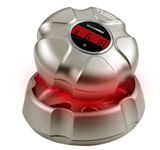- Learn more about:
- Laser Therapy
The X5 Hair Laser is a proprietary hand-held laser used for hair regrowth and designed for home use. It is manufactured by Spencer Forrest, the makers of Toppik and other cosmetic camouflage products. The X5 Hair Laser uses 15 points of laser light to irradiate the scalp. Each pass over the scalp covers an area of over 9 square inches (23cm). The laser output of this system is 30-34mW.
Through a proprietary laser system, the X5 Hair Laser channels the laser light to make direct contact with the scalp, without obstruction of existing hair. The floating laser heads ensure that the laser light channels conform to the shape of the scalp and head. This direct contact is the main differentiating feature of this machine.

Recommended use for the X5 Hair Laser is three times per week in sessions of 10-15 minutes each, with the patient slowly repositioning the device along the scalp in 10-15 second intervals. While more frequent use will not improve results, the frequency of its use can be decreased once the desired results are achieved.
The system comes with a charging unit, making the system completely cordless. This frees the user to do other activities while still administering the laser treatment. When charged, the system can delivery enough power to supply several treatments before the need for recharging.
The X5 is ergonomically designed for comfort of the hand and arm during use. The LCD display on the top of the system helps to ensure that the proper amount of time is elapsed for optimum results. The display also indicates the remaining battery power.
It is recommended that you do not stare at the laser light directly and follow all safety guidelines.
The Spencer Forrest X5 Hair Laser costs approximately $299 and is available at www.x5hairlaser.com.
References:
- National Hair Journal, Summer 2007 Issue.
- Sommer AP, et al. Biostimulatory windows in low-intensity laser activation: lasers, scanners and NASA’s light-emitting diode array system. J Clin Med and Surg, 2001; 19(1); 29-33





